

29-astuces-pour-rester-créatif.jpg (Image JPEG, 453x700 pixels) Idea Generator. Ideation (idea generation) Idea Creation Model. Crowdsourcing vs Collective Intelligence. What's the diff? Thanks to intrepid design blogger, oyster fiend, and “bro”, John DiPalma and his solid blog at DesignRising, I’ve been coerced into writing much richer blog posts about the topics that I’m exploring.
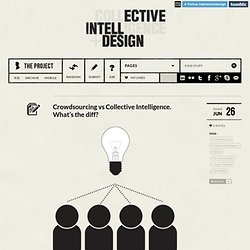
So, here goes the first in a series of attempts to share some meatier topics and the findings that I’m uncovering. As the title of this blog suggests (and if you’ve ventured as far as reading the “Project” section) I’m exploring the role of collective intelligence in design. When I describe my research to people, I usually start with the description of collective intelligence, and then quickly find myself falling back on the more commonly known crowdsourcing. Pensée latérale. Why Creative Thinking is Inclusive Thinking, by Michael Michalko. Albert Einstein was once asked what the difference was between him and the average person.

He said that if you asked the average person to find a needle in the haystack, the person would stop when he or she found a needle. He, on the other hand, would tear through the entire haystack looking for all the possible needles. Why Our Creativity Depends On Who Surrounds Us. 72Share Synopsis.
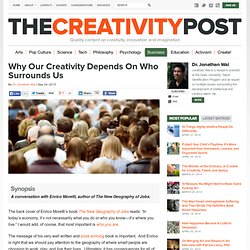
Critical and Creative Thinking - home. CreatingMinds - tools, techniques, methods, quotes and quotations on all matters creative. Management de la créativité. Un article de Wikipédia, l'encyclopédie libre.
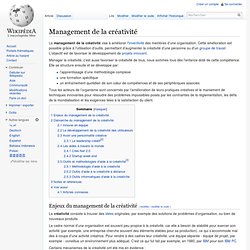
Le management de la créativité vise à améliorer l'inventivité des membres d’une organisation. Cette amélioration est possible grâce à l'utilisation d'outils, permettant d’augmenter la créativité d’une personne ou d'un groupe de travail. L'objectif est de favoriser le développement de projets innovant. Manager la créativité, c’est aussi favoriser la créativité de tous, nous sommes tous dès l'enfance doté de cette compétence. Elle se structure ensuite et se développe par: l’apprentissage d’une méthodologie complexeune formation spécifiqueun entraînement quotidien de son cœur de compétences et de ses périphériques associés.
The Creative Thought Process - Part One. One of the big parts of being an Event Designer is the creation of an event.
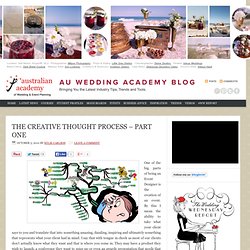
By this I mean the ability to take what your client says to you and translate that into something amazing, dazzling, inspiring and ultimately something that represents what your client had in mind. I say that with tongue in cheek as most of our clients don’t actually know what they want and that is where you come in. They may have a product they wish to launch, a conference they want to spice up or even an awards presentation that needs that extra something. The Creative Process scenic route. Orloev.com. Do not follow the steps of your predecessors but do look for what they have been looking for.

"I may not be cleverer than the others but I have a method" Rene Descartes (1596 - 1650) I first heard the name of Rene Descartes, one of the greatest minds and founder of the new philosophy during the first semesters of my university studies. Creative thought. Category:Creativity Techniques. This A to Z of Creativity and Innovation Techniques, provides an introduction to a range of tools and techniques for both idea generation (Creativity) and converting those ideas into reality (Innovation).
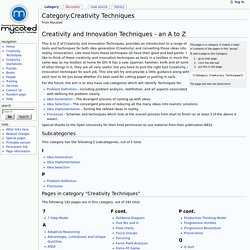
Like most tools these techniques all have their good and bad points. I like to think of these creativity and innovation techniques as tools in a toolbox in much the same way as my toolbox at home for DIY. List of creative thought processes. List of thought processes. Nature of thought[edit] Thought (or thinking) can be described as all of the following: An activity taking place in a: brain – organ that serves as the center of the nervous system in all vertebrate and most invertebrate animals (only a few invertebrates such as sponges, jellyfish, adult sea squirts and starfish do not have a brain).

It is the physical structure associated with the mind. mind – abstract entity with the cognitive faculties of consciousness, perception, thinking, judgement, and memory. LeadingThoughts - LeadershipNow.com.
6 thinking hats. Problem Solving... Créativité. Un article de Wikipédia, l'encyclopédie libre.

Marina Bay Sands à Singapour. Sur les autres projets Wikimedia : créativité, sur le Wiktionnaire créatif, sur le Wiktionnaire. Critical and Creative Thinking - SCAMPERTechnique. Creativity Quotes. From Mycoted The quotations here fall into two main categories.
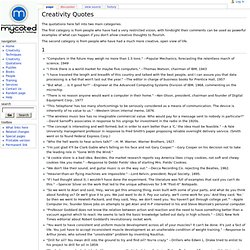
The first category is from people who have had a very restricted vision, with hindsight their comments can be used as powerful examples of what can happen if you don't allow creative thoughts to flourish. The second category is from people who have had a much more creative, open view of life. "Computers in the future may weigh no more than 1.5 tons. " Thinking skills. There is no logic in connecting an office copier with 'nose'. That is to say, there is no 'logic' in our normal undertanding of logic. This understanding is based on passive surface information systems. There is, however, the logic of active surface information systems, and that is the logic of a patterning system. In such a system, the putting together of 'copier' with the random input 'nose' is perfectly logical. Thinking Methods. Creativity. Creativity is a phenomenon whereby something new and somehow valuable is formed, such as an idea, a scientific theory, an invention, a literary work, a painting, a musical composition, a joke, etc.
Scholarly interest in creativity involves many definitions and concepts pertaining to a number of disciplines: psychology, cognitive science, education, philosophy (particularly philosophy of science), technology, theology, sociology, linguistics, business studies, songwriting, and economics, covering the relations between creativity and general intelligence, mental and neurological processes, personality type and creative ability, creativity and mental health; the potential for fostering creativity through education and training, especially as augmented by technology; and the application of creative resources to improve the effectiveness of teaching and learning. Definition[edit] Aspects[edit] Making Good Lessons Great: Incorporating Multiple Iintelligences and Creative Thinking into Everyday Lesson Plans « clearings.
By Betty K. Wood and Andrew L. Hunt, University of Arkansas at Little Rock Sarah C. Wood-Jenkins, Ball State University I didn’t find anything very revolutionary here except this quote which I shall bear in mind (lay-out is mine): A CoCreative Path — Nurturing a Culture for Collaborative Innovation. Design thinking.
Design thinking stands for design-specific cognitive activities that designers apply during the process of designing.[1] Overview[edit] Design thinking has come to be defined as combining empathy for the context of a problem, creativity in the generation of insights and solutions, and rationality in analyzing and fitting various solutions to the problem context.[2] According to Tim Brown, CEO and president of IDEO, the goal of Design Thinking is "matching people’s needs with what is technologically feasible and viable as a business strategy" [3] The premise of teaching Design Thinking is that by knowing about how designers approach problems and the methods which they use to ideate, select and execute solutions, individuals and businesses will be better able to improve their own problem solving processes and take innovation to a higher level.
Origins of the term[edit] (For a detailed evolution, see History, below.) Transdisciplinarité. Un article de Wikipédia, l'encyclopédie libre. La transdisciplinarité est une posture scientifique et intellectuelle. Elle a pour objectif la compréhension de la complexité du monde moderne et du présent. Le mot transdisciplinarité a été inventé par Jean Piaget, en 1970. Éclairage du concept[modifier | modifier le code] La transdisciplinarité est définie par Basarab Nicolescu par trois postulats méthodologiques : l'existence de niveaux de réalité et de perception, la logique du tiers inclus et la complexité. La transdisciplinarité se distingue ainsi de la pluridisciplinarité et l’interdisciplinarité en ce sens qu’elle déborde les disciplines d’une part, mais surtout d’autre part que sa finalité ne reste pas inscrite dans la recherche disciplinaire proprement dite.
Ainsi, comme l’indique son préfixe « trans », la transdisciplinarité est la posture scientifique et intellectuelle qui se situe à la fois entre, à travers et au-delà de toute discipline. 100-Whats of Creativity. A 5-Step Technique for Producing Ideas circa 1939. The Creativity Post. Tools for creating ideas. Lateral thinking. Lateral thinking is solving problems through an indirect and creative approach, using reasoning that is not immediately obvious and involving ideas that may not be obtainable by using only traditional step-by-step logic.
The term was coined in 1967 by Edward de Bono. [1] According to de Bono, lateral thinking deliberately distances itself from standard perceptions of creativity as either "vertical" logic (the classic method for problem solving: working out the solution step-by-step from the given data) or "horizontal" imagination (having many ideas but being unconcerned with the detailed implementation of them). Methods[edit] Oblique Strategies. Rino Breebaart ¦ Oblique Strategies for Writers. The Indicator: Oblique Strategies for Architects. Oblique strategies - defeat creative block. Creative writing. L'écriture créative.
Tackle Any Issue With a List of 100. The List of 100 is a powerful technique you can use to generate ideas, clarify your thoughts, uncover hidden problems or get solutions to any specific questions you’re interested in. The technique is very simple in principle: state your issue or question in the top of a blank sheet of paper and come up with a list of one hundred answers or solutions about it. “100 Ways to Generate Income”, “100 Ways to be More Creative” or “100 Ways to Improve my Relationships” are some examples.
“One hundred entries? Isn’t that way too many?” Bear with me: it’s exactly this exaggeration that makes the technique powerful. When starting your list you may believe that there’s no way to get it done. Creative manifesto. “The world without spirit is a wasteland. Reinventing Discovery: The New Era of Networked Science. 7 Steps To Compel Creativity. Reinventing Discovery: The New Era of Networked Science - Michael Nielsen - Google Books.
Thinking outside the box. Imagination active. WHERE GOOD IDEAS COME FROM by Steven Johnson. Creative Thinking Is a Specific Process That Can Be Replicated. 10 Paradoxical Traits Of Creative People. Design is also a Recursive Activity. 8 Types Of Imagination. Mind Wandering: A New Personal Intelligence Perspective. A taxonomy of models used in the design process. The EUREKA! moment. Thinking like a genius: overview. Welcome to Enchanted Mind - HOME. Project Renaissance with Win Wenger, Ph.D. Creativity & Innovation Consulting, Executive education, Training, Coaching innovators, Speaking. Creative thinking with creative geniuses like you!
How 2 think like Leonardo Da Vinci. Nikola Tesla's Best Productivity Tricks. How to Think Like Sherlock Holmes: Lessons in Mindfulness and Creativity from the Great Detective.